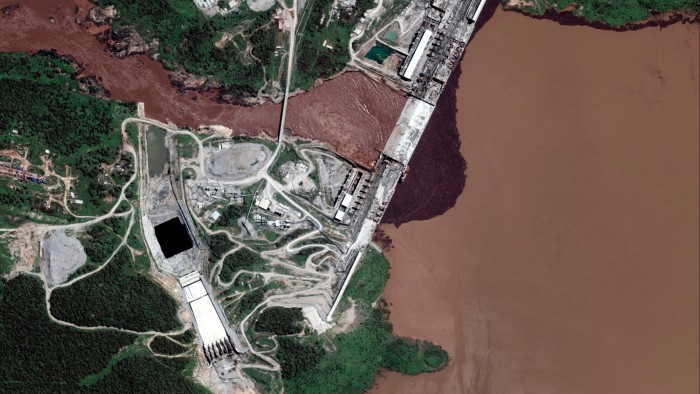Unlock the Editor’s Digest without cost
Roula Khalaf, Editor of the FT, selects her favorite tales on this weekly e-newsletter.
Ethiopia will probably be celebrating a improvement milestone when it formally opens Africa’s largest hydropower dam on the Blue Nile river on Tuesday, however for Sudan and Egypt downstream the launch is not any cause to rejoice.
After years of failed negotiations, each downstream nations warned of “grave penalties” within the absence of an settlement on how water flows will probably be managed as soon as the Grand Ethiopian Renaissance Dam, or Gerd, turns into totally operational.
Building of the dam has fuelled nationalist fervour in Egypt, which depends on the Nile for nearly all of its water wants, and likewise in Ethiopia, the place use of the river is seen as a sovereign proper and the place members of the general public contributed to its financing by crowdfunding.
Celebrations for the opening of the 5,150MW capability dam, which has been beneath building for 14 years, will probably be held throughout Ethiopia, in accordance with the international ministry in Addis Ababa.
The Ethiopian authorities can also be hoping that quite a few African heads of state attending a local weather summit in Addis Ababa may even attend the inauguration on the dam itself.
“For Ethiopians it is a celebration of a generational aspiration . . . to utilize this pure useful resource for improvement,” mentioned international ministry spokesperson Nebiat Getachew.
The Blue Nile, which originates in Ethiopia and joins the White Nile in Sudan’s capital Khartoum earlier than flowing into Egypt, offers 85 per cent of the waters of the mixed river.
Getachew mentioned that the dam, in addition to offering entry to electrical energy for among the almost half of the 120mn Ethiopian inhabitants who dwell with out it, would carry advantages to downstream nations within the type of flood management and energy buy agreements.
“The primary factor is we don’t envisage for Egypt or Sudan to have shortages of water provide. For us it isn’t an Ethiopian dam. It’s a regional dam with collective aspirations.”
However Sudan and Egypt repeated in a joint assertion final week that the Renaissance Dam “breached worldwide regulation and would trigger grave penalties to the 2 downstream nations”.
They described it as a “persevering with menace” to water safety within the east Nile, citing “severe considerations” on account of Ethiopia’s “unilateral steps” in filling and working the Gerd.
Egypt, a rustic of 110mn folks, is totally reliant on the Nile for its agricultural and different water wants and now finds that what it has thought-about its rightful share of water may very well be threatened by developments upstream.
The Egyptian and Sudanese positions have been underpinned by a bilateral treaty between the 2 nations signed in 1959 governing use of the Nile’s sources.
Ethiopia describes that treaty, which didn’t bear in mind the opposite riparian states, as “out of date” and has received help from Burundi, Rwanda, Kenya, South Sudan and Uganda. They’ve joined Ethiopia in a brand new Nile River Basin Cooperative Framework Settlement, which got here into drive in October 2024.
Egypt contends that Ethiopia has persistently stymied efforts to succeed in a binding settlement to ensure that agreed portions could be discharged from the dam throughout extended or extreme droughts, when Ethiopia would possibly wish to construct up ranges within the reservoir for hydropower era.

The dam has step by step elevated electrical energy era in the course of the interval it has been crammed, with six of its 13 generators already functioning. On Tuesday, in accordance with the international ministry in Addis Ababa, all of them will probably be used.
“There have been no opposed impacts downstream in the course of the filling of the Gerd reservoir,” mentioned Ana Cascao, an unbiased advisor and Nile specialist. “But when extreme or extended droughts happen sooner or later, damaging impacts can certainly happen. These can solely be minimised by a co-operative settlement acceptable to all events.”
Some technical co-operation is already happening between Ethiopia and Sudan, which has an older dam, inbuilt 1966, solely 70 miles downstream from the Gerd.
Getachew from the Ethiopian international ministry mentioned that Ethiopia desires a collaborative method with Sudan and Egypt and stays open to reaching settlement on how water flows are managed, describing the waters of the Nile as a “shared useful resource”.

